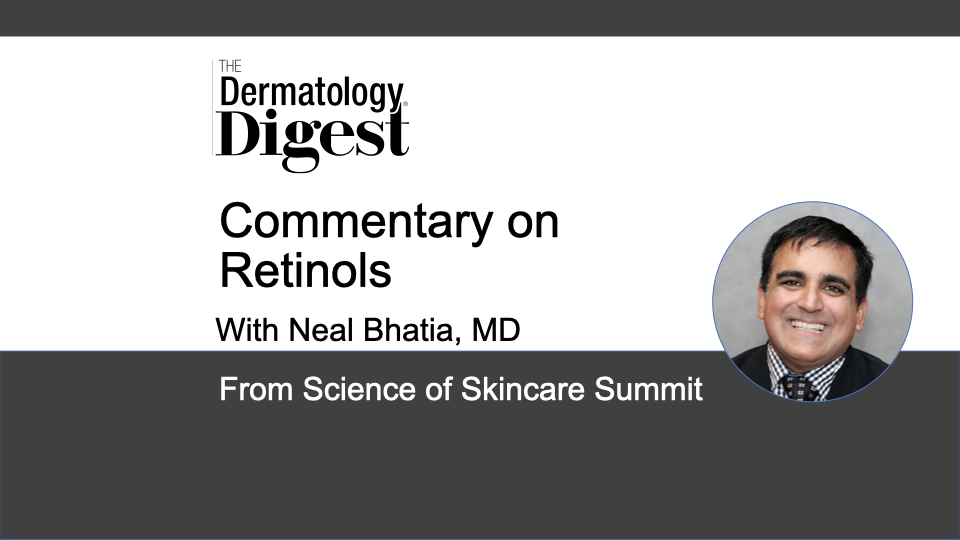Dr. Neal Bhatia discusses the evolution of retinol formulations and how retinol remains a go-to treatment in medical and aesthetic dermatology practices.
Neal Bhatia, MD, Director of Clinical Dermatology at Therapeutics Clinical Research in San Diego, California
“There are a lot of opportunities with retinols [in dermatology practice], either over the counter [OTC] or office dispensed, especially with some new formulations that are built on some of the new generations of therapy,” said Dr. Neal Bhatia who presented “Retinols” at the Science of Skincare Summit in Austin, Texas.
Generations of Retinol
There are generations of retinols, according to Dr. Bhatia.
“The first generation of retinoids are monoaromatic; the second generation is a little more synthetic and has a benzene ring. Those are in the old-school tretinoin, isotretinoin, and etretinate family. Tretinoin also was a first generation based on the retinoic acid receptor binding, as well as isotretinoin, which we’re all familiar with.”
The third generation of retinols are typically seen in prescription grade, like adapalene, tazarotene, and tretinoin, said Dr. Bhatia. The fourth generation is trifarotene (AKLIEF, Galderma), which is also prescription.
“The idea is that retinol is metabolized. It starts as a retinyl ester and works its way to retinol and retinaldehyde and then is metabolized to what we identify as topical retinoids.”
Dermatologists may want patients and consumers to be aware of the different pathways, so they understand what the active ingredients are and how potent they are, said Dr. Bhatia.
“Of course, retinol topically has a lot of activity and impact on the integrity of both the dermal stroma and on epidermal turnover. Retinols stimulate angiogenesis, which means more flow of blood into the dermis of the collagen.”
The next step for dermatologists is to educate consumers about how to use retinols and retinoids safely and correctly, said Dr. Bhatia.
“Make sure they moisturize and cleanse to reduce and dryness or desquamation effects.”
Newer Data
There are good studies on retinoid use in skin of color, said Dr. Bhatia.
“One was done by Neutrogena and J&J where they looked at erythema, dryness, scaling, and irritation and found that some of the new formulations help with patient concerns about pigmentation, as well as some of the other issues, such as stabilization. As early as 4 weeks and as late as 8 weeks, in a small trial, they found significant improvement in fine lines, crow’s feet, and sallow dyschromia.”
There’s also good 52-week data using the more processed and established retinols, said Dr. Bhatia.1
“Retinol serum, which is a really new approach, is showing good utility—not just in getting improvement in rejuvenation effects but with patient satisfaction. My patients prefer serums over creams or gels because of the reduced local skin reactions as well as the potential for less irritation.”
Understanding the new concept of retinol versus tretinoin is important, said Dr. Bhatia.
“There are two ingredients. One is called neurosensine, which is a synthetic dipeptide that actually helps to improve and reduce the chain reactions of collagen degradation, which can be potentially irritating. The other compound, called madecassoside, has a really good antiaging approach. It works by inhibiting Interleukin 1 (IL-1) and prostaglandin E2 (PGE2), which are important for vasomotor activity, as well as reducing inflammatory cascades that are induced by retinoids.”
Another new concept is called Alpharet (SkinBetter Science), which is an overnight cream based on retinoid metabolism. Alpharet includes other ingredients like squalene, niacinamide, and potent antioxidants like vitamins A and C, he said.
“Bisabolol and glycolic acid are also added to add to the potency. There are a couple of good studies with Alpharet in terms of the tolerability and patient assessment.”2
“This information is for every dermatologist—not just those who are aesthetically driven but for all of us—to be aware of the consumer perception as well as the potential utility,” said Dr. Bhatia.
References:
- Randhawa M, Rossetti D, Leyden JJ, et al. One-year topical stabilized retinol treatment improves photodamaged skin in a double-blind, vehicle-controlled trial. J Drugs Dermatol. 2015 Mar;14(3):271-80. PMID: 25738849..
- McDaniel DH, Mazur C, Wortzman MS, et al. Efficacy and tolerability of a double-conjugated retinoid cream vs 1.0% retinol cream or 0.025% tretinoin cream in subjects with mild to severe photoaging. J Cosmet Dermatol. 2017 Dec;16(4):542-548. doi: 10.1111/jocd.12381. Epub 2017 Aug 1. PMID: 28762645.
Disclosures: Dr. Bhatia reports affiliations with Abbvie, Almirall, Arcutis, Beiersdorf, Biofrontera, BMS, BI, Dermavant, EPI Health, Ferndale, Galderma, InCyte, ISDIN, J&J, LaRoche-Posay, Leo, Lilly, Ortho, Pfizer, P&G, Regeneron, Sanofi, SunPharma, and Verrica.


